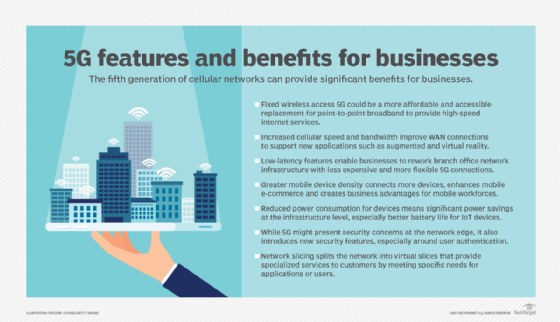The essential 5G glossary of key terms and phrases
To understand 5G, delve into the terminology that shapes the technology. This glossary of 14 5G keywords explains what 5G is and how its features work.
`As the newest generation of cellular technology, 5G has a variety of moving parts and new features that can transform traditional networking. A good place to start with these shifting facets is to learn exactly what they are.
This 5G glossary dives into the terminology, definitions and relationships of 14 key terms and phrases regarding the next generation of mobile networks. With everything from the project group that developed 5G standards to the smallest technologies that make 5G possible, this essential 5G glossary can help establish the vocabulary necessary not only for the future of mobile networks, but for networking in its entirety.
Explore the following 5G key words and phrases to gain an overall understanding of this technology.
5G explained: The essential 5G glossary
3GPP. Various telecommunications organizations, including AT&T, the former Nortel Networks and British Telecom, developed the 3rd Generation Partnership Project to create standards for 3G technology. Since then, 3GPP has continued to develop standards for succeeding wireless generations, including 5G. This project uses standards based on the Global System for Mobile communication specifications and radio access technology.
5G. Fifth-generation wireless, or 5G, is the next generation of cellular network technology. The goal of 5G is to increase network speed and responsiveness to provide real-time communications and to move data at faster speeds. Many new features -- addressed in this 5G glossary -- accompany 5G.
5G Advanced. 5G Advanced is the next evolution of 5G technology announced by 3GPP in 2021 that is expected to bring 5G to its fullest capabilities. 5G Advanced is another name for Release 18 and future releases of 5G specifications. It uses AI and machine learning to improve network performance and offers up to 20% higher data rates than 5G. 5G Advanced addresses the growth in demanding applications, such as live video streaming and other real-time applications. It's expected to enable a wider set of use cases for organizations in vertical industries -- one of the initial promises of 5G. 5G Advanced is backward-compatible, so it can coexist with current 5G New Radio (5G NR) releases and serve legacy 5G devices.
5G NR. The set of standards called 5G New Radio replaces the Long-Term Evolution (LTE) standard, with goals to support wireless communication growth with enhanced electromagnetic radiation spectrum efficiency. In December 2017, 3GPP released 5G NR specifications and updated several performance and connectivity requirements for connections to qualify as 5G NR. It was designed as a global standard for the air interface of 5G networks and is based on orthogonal frequency-division multiplexing (OFDM).
Fixed wireless. Fixed wireless broadband is one of two types of 5G services; the other is cellular technology. Fixed wireless comprises wireless systems and devices in fixed locations, such as offices and homes. Subscribers receive internet access in areas with no fiber optic internet infrastructure -- often in rural areas. Fixed wireless internet broadcasts to receivers through airwaves ISPs install on users' properties. To work, the receiver needs to be about no more than 10 miles from the service provider's tower.
Latency. Network latency is the amount of delay or time that packets take to travel between points. Latency is the main difference between 4G and 5G, as 4G offers latency of 60 to 98 milliseconds and 5G promises latencies perhaps as low as 3 ms. Ultralow latency enables 5G to provide users with real-time communication abilities, such as reliable audio and video streaming, and is expected to help deliver virtual reality, IoT and AI.
LTE. Long-Term Evolution is a 4G wireless standard that sets the groundwork for 5G technology. LTE offers increased capacity and speed, as well as high peak data transfer rates. 3GPP also developed LTE to unify wireless broadband standards globally. LTE supports various types of traffic, including voice, video and messaging.

Millimeter wave. MmWave is a band of radio spectrum between 30 GHz and 300 GHz and provides high-speed broadband connections to transfer data. 5G operates on this band of spectrum. MmWave spectrum travels at high frequencies in short, direct wavelengths, which is called line-of-sight travel. MmWave can offer high-speed, point-to-point wireless LANs. Due to the nature of mmWave, atmospheric changes, like increased humidity, and physical walls can affect performance and signal strength because the waves are absorbed by gases and moisture in the atmosphere, which reduces the range and strength of the waves.
MIMO. MIMO stands for multiple input, multiple output, which is a transmission technology comprising multiple antennas for communication at sources and their destinations. MIMO uses smart antenna technology that combines available antennas for fewer potential errors in data transmissions and for optimized data speeds. 5G uses massive MIMO -- an extension of MIMO using more transmit and receive antennas to help providers prepare their networks to support increased amounts of data. Massive MIMO boosts users' bandwidth and supports more users per antenna.
Network slicing. Network slicing is a virtual network overlay architecture that can separate virtual networks into individual partitions -- or slices -- that support different services and applications, all residing on the same hardware. Each slice has its own architecture, management and security. This architecture divides the user plane and control plane so the user planes move closer to the network edge. Network slicing is a major capability of 5G that 4G cellular and other generations couldn't support.
OFDM. Orthogonal frequency-division multiplexing is a method of encoding data on multiple carrier frequencies. In this data transmission method, a single data stream is split over separate narrowband subchannels with different frequencies. These separate channels help reduce and avoid interference. OFDM encoding is part of 5G's framework, with channels between 100 MHz and 800 MHz.
RAN. Radio access networks are the parts of a telecommunications network that connect user devices to various parts of a mobile network using a radio connection. The most recent RAN evolution divides the user plane and control plane into separate elements, which enables various 5G features, such as network slicing and MIMO, to function properly.
RTC. With real-time communications, users can instantly share information and data with little to no latency. RTC provides direct access from sources to destinations, as these live communications don't require storage. RTC is a touted capability of 5G networks.
Small cell. Small cells are physically small, low-powered radio frequency base stations built to improve wireless network efficiency and coverage with improved signal penetration. Small cells have the capacity to transfer low-, medium- and high-band data spectrum, such as mmWave. Because of 5G's ability to offer high speeds within limited ranges, small cells can boost and ensure reliable signal strength to benefit 5G signals. Unlike cell towers, small cells are located every few blocks instead of miles.
Editor's note: This article was updated to include additional 5G terms.





